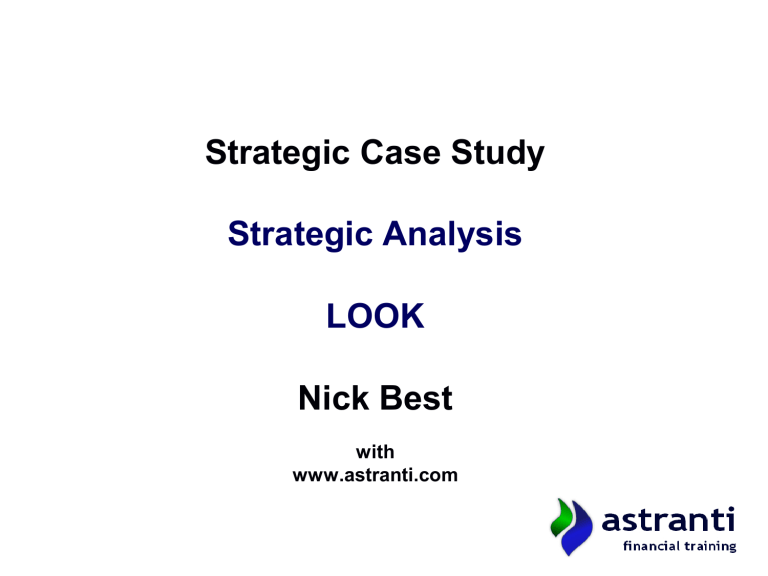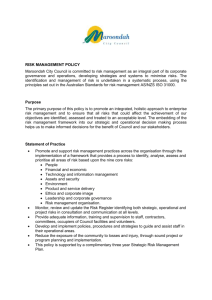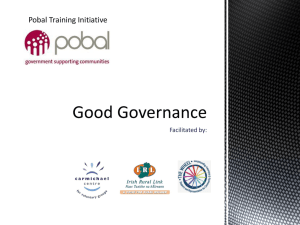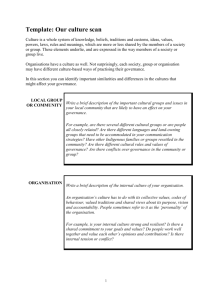Strategic Case Study Strategic Analysis LOOK Nick Best

Strategic Case Study
Strategic Analysis
LOOK
Nick Best
with www.astranti.com
Introduction to the case
The search engine industry is the focus for the latest Strategic Case Study.
That will no doubt be a relief to many of you, as it is an industry which is very familiar to us all. We’ve all used search engines, or got mobile phones or tablets (the two key industries they are involved in) and most of us are probably very aware of the products that Google produce, and Look, our preseen company, look a lot like Google!
Look is a successful company operating worldwide. It has growing revenues, strong margins, and a loyal customer base.
It has a wide range of products, from a cash cow in the search engine market to mobile phone related products, much like Google's Android, Google Play store and Nexus, and a Google Glass style of contact lens business in the development.
An interesting business for us to analyse, so let's begin!
Strategic analysis – the rational model
This analysis uses the rational planning model of strategic analysis, summarised in the following diagram
Governance
Business Environment & Ethics
PESTEL 5 Forces
Internal analysis
S W
NOW
O T
Business Strategy
Generic strategies
Ansoff’s matrix
Method of growth
FUTURE
Mission &
Objectives
Product analysis
-Product life cycle
-BCG matrix
Stakeholder
Mapping
If you need a reminder of any of the theories, see our SCS Study Text part 2 which summaries all the key SCS relevant models from E3, F3 and P3!
Strategic analysis – the rational model
The first stage of analysis is to ensure we fully understand where the organisation is heading, along with its approach to meeting stakeholder needs.
FUTURE
Mission &
Objectives
Governance
& Ethics
Stakeholder
Mapping
Mission - introduction
What is the organisation all about? Why does it exist? Who does it exist for? What is it trying to achieve? An organisation’s mission answers these questions.
A mission helps to provide common purpose, focus for the organisation's strategy and provide direction to directors to guide objectives and strategic thinking. An organisation without a strong mission may lack focus and purpose and the strategic direction may be confused.
Campbell set out the following key elements of good mission statements:
Purpose
Why does the organisation exist? For whom does it exist?
What does the organisation hope to achieve long term?
Strategy
How will the organisation compete? The range of businesses it is operating within
Values
What the organisation stands for (quality, value for money, innovation etc.)
Policies
Policies people are expected to follow which will ensure people act according to the defined values, strategy and purpose .
Mission for the case study
Here's the company's mission statement: “Connecting people to the World”
Unfortunately Look's mission statement is of limited use as it so broad and generic. It's not useful for us to analyse the business, or the directors of the business to drive its direction, after all what does that really mean? If we were given a new project to assess in the exam could we use the mission to test whether the project was on track towards the company's ultimate aim? No!
The case does give us a better 'underlying intention' of:
“To make knowledge in almost any form instantly accessible to those using the company's services”.
This links to the Search and Mapping products closely, although is perhaps not quite so well linked to their mobile phone and media product range. Is providing films and TV necessarily 'knowledge'. Does that mean that Look Media is off track or simply that the mission is not well written or well focused? Probably the latter which means that writing a more robust mission based on Campbell's 4 elements is, without doubt, a possible exam question.
Objectives and performance measurement
The objectives provide a focused target to move towards to direct planning, motivate staff and enable accurate performance measurement
We are given few specific targets in the case study.
They are likely to have more specific strategic targets we are not told about. If the unseen suggests they do not, then this is a weakness in the company’s planning approach.
The divisional structure would be appropriate for using investment centre measure of ROI and RI .
The balanced scorecard would work well too – there is little evidence of robust non-financial performance measurement in the case
Governance
Corporate governance is the way organisations are directed, administered and controlled, with the aim of ensuring that the organisation is run in a way that is right for all stakeholders, in particular the shareholders.
According to the UK Code of Corporate governance, good governance includes:
Separate Chairman and CEO
Independent NEDs
Audit, nomination and remuneration committees
Risk management focus a
Disclosures of directors and pay
Financial reporting and control
Information for directors to facilitate good decision making
All directors involved in decision making (are founders too powerful)
Regular meetings with institutional shareholders
Good use of the Annual General Meeting (AGM)
Governance – applied to the case study
• Look have 4 Non-executive Directors (including the Chair) – less than 50% of directors and so not good practise under the combined code
• Independent Non-Executive Chairman – that's good and he's experienced and an accountant so good as head of the audit committee
• Well staffed internal audit department – facilitates independent review – risk based – compliance focused
• Audit and remuneration committees – good governance
• No nomination committee – evidence of poor recruitment (Mara)
• Founders have 20 votes for each share giving them over-riding control of the business – lack of control for shareholders, particularly if they are not happy. A key point likely to be an exam Q.
• Little evidence in the case of other key governance issues. They are listed so should conform to governance requirements and probably do, but look out for weaknesses in the unseen in areas such as:
Disclosures of directors and pay
Financial reporting and control
Information for directors
All directors involved in decision making (are founders too powerful)
Regular meetings with institutional shareholders
Good use of the AGM
The range of governance issues in this case study are more than most previous case studies, suggesting the examiner has governance as a key topic in mind to test in this exam
Ethics and CSR
In the case study exam in its previous incarnation as the T4 case study, ethics was a guaranteed 10 marks in every exam. In the pilot paper of the SCS exam it was worth even more marks than that, and with 25 “people skills marks” this is a trend we expect to continue, not the least because CIMA insist ethics is a vital element of being a qualified accountant, and it is something which is tested throughout your studies.
It might be that you have a specific ethical requirement . In the pilot paper this consisted of one full part worth 13 people skills. However, in addition to that you should consider the ethical and corporate social responsibility elements to every section you are attempting .
On the following page you'll find the key issues either mentioned in the case or relevant to the case scenario. Ensure you understand each issue and a ready to answer a question on them!
Ethics – applied to the case study
Ethics code covers following key areas:
• Serve users
– e.g. do what is right for customers – good search, fair policies
• Respect others
– e.g. customers, staff, suppliers – look out for any poor treatment for any stakeholder group and mention it is against the company's code
• Protect privacy
– key issue mentioned throughout the case and highly likely exam topic
• Respect external regulations
– Consider laws in different parts of the world
• Work in Look's best interests
– Meet shareholder needs
Other possible issues:
- Staff at suppliers (Apple have been criticised for this and so it is a 'current' issue)
- Freedom of information (e.g. China restricted internet access)
- Environmental good
Expect to see an ethics issue in the exam, and if you do, always take the ethical high ground.
That's what CIMA expect of you!
Corporate Social Responsibility – applied to the case study
CSR is important to Look, so in the exam you should consider the impact of all stakeholders in your recommendations, on any issue to consider. Specific issues covered in the case study include:
• Environmental issues
– Reduced energy consumption in data centres
– Energy audits
– Carbon neutral (using carbon offsets)
– Renewable energy sources research ($1.1bn)
– Upgrade equipment rather than renew
– No pollution
– Encourage public transport and local food
• Products
– Some social good of products e.g. finding information
• Staff
– Excellent HR and staff treatment
• Community
– Schools scheme
– Charitable support
Critical Success Factors - introduction
Critical success factors are the key things the organisation must do well if it is to succeed. It is critical therefore that each
CSF for the case study organisation is developed and improved to ensure that it is a strength of the business
If new strategies recommended in the unseen which support these CSFs then that is evidence to you that you should support the strategy (as long as it is realistic in other ways e.g. it's not too expensive).
If something in the unseen is contradictory to these CSFs then not, then you should question whether they are appropriate.
Critical Success Factors – applied to the case
The following are critical success factors:
• Robust data management/IT infrastructure
• Security of data and personal information
• Research and development
• Searching is effective and accurate
• Good quality – information, services, phones
• Brand and reputation
• Skilled programmers
The big hints in the preseen related to these issues are for security and skilled programmers, so look out for these as likely issues in your exam.
The rest of the analysis!
You can purchase the rest of Nick's analysis in two ways
(1) On Nick's Preseen analysis videos – 10 videos analysing the preseen case study (including an hour and 20 minutes on the strategic analysis)
AND/OR
(2) Purchasing the full strategic analysis, industry analysis and top 10 issues.








